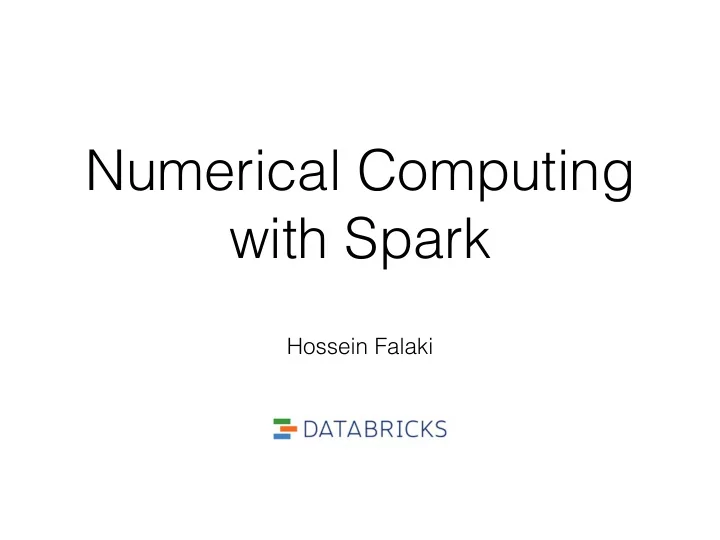

Numerical Computing with Spark Hossein Falaki
Challenges of numerical computation over big data When applying any algorithm to big data watch for 1. Correctness 2. Performance 3. Trade-off between accuracy and performance 2
Three Practical Examples • Point estimation (Variance) • Approximate estimation (Cardinality) • Matrix operations (PageRank) We use these examples to demonstrate Spark internals, data flow, and challenges of implementing algorithms for Big Data. 3
1. Big Data Variance The plain variance formula requires two passes over data Second pass N Var ( X ) = 1 ∑ ( x i − µ ) 2 N i = 1 First pass 4
Fast but inaccurate solution Var ( X ) = E [ X 2 ] − E [ X ] 2 ∑ ∑ 2 ⎛ ⎞ x 2 x = − ⎜ ⎟ ⎝ ⎠ N N Can be performed in a single pass, but Subtracts two very close and large numbers! 5
Accumulator Pattern An object that incrementally tracks the variance Class RunningVar { var variance: Double = 0.0 � // Compute initial variance for numbers def this(numbers: Iterator[Double]) { numbers.foreach(this.add(_)) } � // Update variance for a single value def add(value: Double) { ... } } 6
Parallelize for performance • Distribute adding values in map phase • Merge partial results in reduce phase Class RunningVar { ... // Merge another RunningVar object // and update variance def merge(other: RunningVar) = { ... } } 7
Computing Variance in Spark • Use the RunningVar in Spark doubleRDD .mapPartitions(v => Iterator(new RunningVar(v))) .reduce((a, b) => a.merge(b)) • Or simply use the Spark API doubleRDD.variance() 8
2. Approximate Estimations • Often an approximate estimate is good enough especially if it can be computed faster or cheaper 1. Trade accuracy with memory 2. Trade accuracy with running time • We really like the cases where there is a bound on error that can be controlled 9
Cardinality Problem Example : Count number of unique words in Shakespeare’s work. • Using a HashSet requires ~10GB of memory • This can be much worse in many real world applications involving large strings, such as counting web visitors 10
Linear Probabilistic Counting 1. Allocate a bitmap of size m and initialize to zero. A. Hash each value to a position in the bitmap B. Set corresponding bit to 1 2. Count number of empty bit entries: v count ≈ − m ln v m 11
The Spark API • Use the LogLinearCounter in Spark rdd .mapPartitions(v => Iterator(new LPCounter(v))) .reduce((a, b) => a.merge(b)).getCardinality • Or simply use the Spark API myRDD.countApproxDistinct(0.01) 12
3. Google PageRank Popular algorithm originally introduced by Google 13
PageRank Algorithm PageRank Algorithm • Start each page with a rank of 1 • On each iteration: curRank contrib = A. | neighbors | ∑ curRank = 0.15 + 0.85 B. contrib i neighbors 14
PageRank Example 1.0 1.0 1.0 1.0 15
PageRank Example 1.0 0.5 1.0 1.0 1.0 1.0 0.5 0.5 1.0 16
PageRank Example 1.85 0.58 1.0 0.58 17
PageRank Example 1.85 0.5 0.58 1.85 0.58 1.0 0.29 0.5 0.58 18
PageRank Example 1.31 0.39 1.72 0.58 19
PageRank Example 1.44 Eventually 0.46 1.37 0.73 20
PageRank as Matrix Multiplication • Rank of each page is the probability of landing on that page for a random surfer on the web • Probability of visiting all pages after k steps is V k = A k × V t V : the initial rank vector A : the link structure (sparse matrix) 21
Data Representation in Spark • Each page is identified by its unique URL rather than an index • Ranks vectors ( V ): RDD[(URL, Double)] • Links matrix ( A ): RDD[(URL, List(URL))] 22
Spark Implementation val links = // load RDD of (url, neighbors) pairs var ranks = // load RDD of (url, rank) pairs � for (i <- 1 to ITERATIONS) { val contribs = links.join(ranks).flatMap { case (url, (links, rank)) => links.map(dest => (dest, rank/links.size)) } ranks = contribs.reduceByKey(_ + _) .mapValues(0.15 + 0.85 * _) } ranks.saveAsTextFile(...) 23
Matrix Multiplication • Repeatedly multiply sparse matrix and vector Same file read � over and over Links (url, neighbors) Ranks (url, rank) … iteration 1 iteration 2 iteration 3 24
Spark can do much better • Using cache(), keep neighbors in memory • Do not write intermediate results on disk Grouping same RDD � over and over Links (url, neighbors) Ranks (url, rank) … join join join 25
Spark can do much better • Do not partition neighbors every time partitionBy Links (url, neighbors) Same node Ranks (url, rank) … join join join 26
Spark Implementation val links = // load RDD of (url, neighbors) pairs var ranks = // load RDD of (url, rank) pairs � links.partitionBy(hashFunction).cache() � for (i <- 1 to ITERATIONS) { val contribs = links.join(ranks).flatMap { case (url, (links, rank)) => links.map(dest => (dest, rank/links.size)) } ranks = contribs.reduceByKey(_ + _) .mapValues(0.15 + 0.85 * _) } ranks.saveAsTextFile(...) 27
Conclusions When applying any algorithm to big data watch for 1. Correctness 2. Performance • Cache RDDs to avoid I/O • Avoid unnecessary computation 3. Trade-off between accuracy and performance 28
Numerical Computing with Spark
Recommend
More recommend